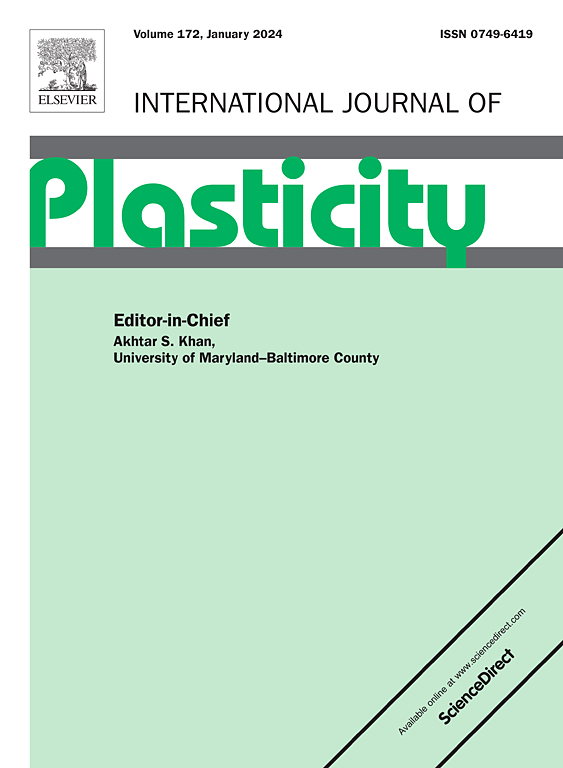Shear banding mediated fracture mechanisms in additively manufactured IN738 superalloys under low-strain-rate loading
IF 9.4
1区 材料科学
Q1 ENGINEERING, MECHANICAL
引用次数: 0
Abstract
Shear banding coupled with grain refinement plays a critical role in fracture behavior under dynamic loading and (very) high-cycle fatigue but is rarely observed during low-strain-rate loading. In this study, we report for the first experimental evidence of shear banding mediated fracture mechanism in an electron beam powder bed fusion (EBPBF) fabricated IN738 superalloy upon low-strain-rate (1 × 10−3 s−1) uniaxial tensile loading. The optimized EBPBF process mitigates solidification defects and produces well-aligned columnar grains with a <001> fiber texture along the building direction, achieving superior mechanical properties compared to cast alloys through the synergistic effect of multiple strengthening mechanisms. Notably, the relatively uniform distribution of nano-sized carbides in the EBPBF-fabricated alloys prevents strain-incompatibility cracking caused by coarse carbides in cast alloys and facilitates shear banding mediated transgranular fracture. The shear band, formed due to concentrated plastic deformation along the crack path, is associated with complete grain nanocrystallization and γ′ precipitate fragmentation through intensive dislocations and twinning activities. The formation of shear banding potentially dissipates crack propagation energy and enhances the crack growth resistance. These findings provide new insights into fracture mechanisms and underscore the potential of additive manufacturing for designing damage-tolerant superalloys.
低应变率加载下增材制造IN738高温合金剪切带介导断裂机制
在动加载和(非常)高周疲劳下,剪切带和晶粒细化在断裂行为中起着至关重要的作用,但在低应变率加载下很少观察到。在这项研究中,我们报告了在低应变率(1 × 10−3 s−1)单轴拉伸加载下,电子束粉末床熔合(EBPBF)制造的IN738高温合金剪切带介导断裂机制的第一个实验证据。优化后的EBPBF工艺减轻了凝固缺陷,产生了<;001>;排列良好的柱状晶粒;纤维沿建筑方向织构,通过多种强化机制的协同作用,获得优于铸造合金的力学性能。值得注意的是,在ebpbf制备的合金中,纳米碳化物的相对均匀分布防止了铸造合金中粗大碳化物引起的应变不相容开裂,有利于剪切带介导的穿晶断裂。剪切带是由于沿裂纹路径的集中塑性变形而形成的,与完全的晶粒纳米化和通过强烈的位错和孪晶活动形成的γ′析出相断裂有关。剪切带的形成潜在地耗散了裂纹扩展能,增强了裂纹扩展阻力。这些发现为断裂机制提供了新的见解,并强调了增材制造在设计耐损伤高温合金方面的潜力。
本文章由计算机程序翻译,如有差异,请以英文原文为准。
求助全文
约1分钟内获得全文
求助全文
来源期刊

International Journal of Plasticity
工程技术-材料科学:综合
CiteScore
15.30
自引率
26.50%
发文量
256
审稿时长
46 days
期刊介绍:
International Journal of Plasticity aims to present original research encompassing all facets of plastic deformation, damage, and fracture behavior in both isotropic and anisotropic solids. This includes exploring the thermodynamics of plasticity and fracture, continuum theory, and macroscopic as well as microscopic phenomena.
Topics of interest span the plastic behavior of single crystals and polycrystalline metals, ceramics, rocks, soils, composites, nanocrystalline and microelectronics materials, shape memory alloys, ferroelectric ceramics, thin films, and polymers. Additionally, the journal covers plasticity aspects of failure and fracture mechanics. Contributions involving significant experimental, numerical, or theoretical advancements that enhance the understanding of the plastic behavior of solids are particularly valued. Papers addressing the modeling of finite nonlinear elastic deformation, bearing similarities to the modeling of plastic deformation, are also welcomed.
 求助内容:
求助内容: 应助结果提醒方式:
应助结果提醒方式:


